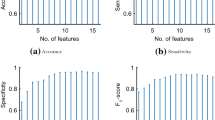Abstract
Various linear and non-linear signal-processing techniques were applied to three-channel uterine EMG records to separate term and pre-term deliveries. The linear techniques were root mean square value, peak and median frequency of the signal power spectrum and autocorrelation zero crossing; while the selected non-linear techniques were estimation of the maximal Lyapunov exponent, correlation dimension and calculating sample entropy. In total, 300 records were grouped into four groups according to the time of recording (before or after the 26th week of gestation) and according to the total length of gestation (term delivery records—pregnancy duration ≥37 weeks and pre-term delivery records—pregnancy duration <37 weeks). The following preprocessing band-pass Butterworth filters were tested: 0.08–4, 0.3–4, and 0.3–3 Hz. With the 0.3–3 Hz filter, the median frequency indicated a statistical difference between those term and pre-term delivery records recorded before the 26th week (p = 0.03), and between all term and all pre-term delivery records (p = 0.012). With the same filter, the sample entropy indicated statistical differences between those term and pre-term delivery records recorded before the 26th week (p = 0.035), and between all term and all pre-term delivery records (p = 0.011). Both techniques also showed noticeable differences between term delivery records recorded before and after the 26th week (p ≤ 0.001).






Similar content being viewed by others
References
Akay M (2001) Nonlinear biomedical signal processing, vol II. Dynamic analysis and modeling. IEEE Inc., New York
Buhimschi C, Boyle MB, Garfield RE (1997) Electrical activity of the human uterus during pregnancy as recorded from the abdominal surface. Obstet Gynecol 90:102–111
Carre P, Leman H, Fernandez C, Marque C (1998) Denoising of the uterine EHG by an undecimated wavelet transform. IEEE Trans Biomed Eng 45(9):1104–1113
Devedeux D, Marque C, Mansour S, Germain G, Duchene J (1993) Uterine electromyography: a critical review. Am J Obstet Gynecol 169(6):1636–1653
Fele-Žorž G (2006) Characterization of emg data. In: Rudel D, Oberžan D (eds) First international workshop on pregnant uterine smooth muscle EMG activity. Institute of biomedical informatics, University of Ljubljana, pp 15–15
Garfield RE, Maner WL, MacKay LB, Schlembach D, Saade GR (2005) Comparing uterine electromyography activity of antepartum patients versus term labor patients. Am J Obstet Gynecol 193(1):23–29
Garfield RE, Maner WL, Maul H, Saade GR (2005a) Use of uterine EMG and cervical LIF in monitoring pregnant patients. Biol J Obstet Gynecol 112(Suppl 1):103–108
Gondry J, Duchgne J, Marque C (1992) First results on uterine EMG monitoring during pregnancy. Int Conf IEEE EMBS 6:2609–2610
Gondry JX, Marque CX, Duchene JX, Cabrol DX (1993) Electrohysterography during pregnancy: preliminary report. Biomed Instrum Technol 27(4):318–324
Iams JD (2003) Prediction and early detection of preterm labor. Am Col Obstet Gynecol 101(2):402–412
Iams JD, Newman RB, Thom EA, Goldenberg RL, Mueller-Heubach E, Moawad A, Sibai BM, Caritis SN, Miodovnik M, Paul RH, Dombrowski MP, Thurnau G, McNellis D (2002) Frequency of uterine contractions and the risk of spontaneous preterm delivery. N Engl J Med 346(4):250–255
Jezewski J, Horoba K, Matonia A, Wrobel J (2005) Quantitative analysis of contraction patterns in electrical activity signal of pregnant uterus as an alternative to mechanical approach. Physiol Meas 26(5):753–767
Kavšek G (2001) Electromiographic activity of the uterus in threatened preterm delivery. Master’s Thesis, University of Ljubljana, Medical faculty, Ljubljana
Lake DE, Richman JS, Griffin MP, Moorman JR (2002) Sample entropy analysis of neonatal heart rate variability. Am J Physiol 283:789–797
Leman H, Marque C, Gondry J (1999) Use of the electrohysterogram signal for characterization of contractions during pregnancy. IEEE Trans Biomed Eng 46(10):1222–1229
Maner WL, Garfield RE (2007) Identification of human term and preterm labor using artificial neural networks on uterine electromyography data. Ann Biomed Eng 35(3):465–473
Maner WL, Garfield RE, Maul H, Olson G, Saade G (2003) Predicting term and preterm delivery with transabdominal uterine electromyography. Obstet Gynecol 101(6):1254–1260
Maner WL, MacKay LB, Saade GR, Garfield RE (2006) Characterization of abdominally acquired uterine electrical signals in humans, using a non-linear analytic method. Med Biol Eng Comput 44(1–2):117–123
Marque C, Duchene J, Leclercq S, Panczer G, Chaumont J (1986) Uterine EHG processing for obstetrical monitoring. IEEE Trans Biomed Eng 33(12):1182–1187
Maul H, Maner WL, Olson G, Saade GR, Garfield RE (2004) Non-invasive transabdominal uterine electromyography correlates with the strength of intrauterine pressure and is predictive of labor and delivery. J Matern Fetal Neonatal Med 15(5):297–301
Meekai ST, Alfirovic Z, Heath VCF, Cicero S, Cacho AM, Williamson PR, Kypros HN (2004) Cervical cerclage for prevention of preterm delivery in women with short cervix: randomised controlled trial. Lancet 363:1849–1853
Nagarajan P, Eswaran H, Wilson J, Murphy P, Lowery C, Preisl H (2003) Analysis of uterine contractions: a dynamical approach. J Matern Fetal Neonatal Med 14:8–20
Rosenstein M, Collins J, De Luca C (1992) A practical method for calculating largest lyapunov exponent from small data sets. Tech rep, Boston University, Neuromuscular research center, Boston
Verdenik I (2002) Multilayer prediction model for preterm delivery. Ph.D. Thesis, University of Ljubljana, Medical faculty, Ljubljana
Verdenik I, Pajntar M, Leskosek B (2001) Uterine electrical activity as predictor of preterm birth in women with preterm contractions. Eur J Obstet Gynecol Reprod Biol 95(2):149–153
Acknowledgments
This work was financed by the Slovenian Research Agency (ARRS) which provided a grant No. 1000-05-310097 and a research project P3-0124—Metabolic and inborn factors of reproductive health, birth.
Author information
Authors and Affiliations
Corresponding author
Rights and permissions
About this article
Cite this article
Fele-Žorž, G., Kavšek, G., Novak-Antolič, Ž. et al. A comparison of various linear and non-linear signal processing techniques to separate uterine EMG records of term and pre-term delivery groups. Med Biol Eng Comput 46, 911–922 (2008). https://doi.org/10.1007/s11517-008-0350-y
Received:
Accepted:
Published:
Issue Date:
DOI: https://doi.org/10.1007/s11517-008-0350-y




